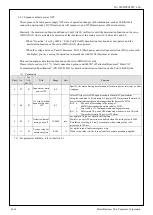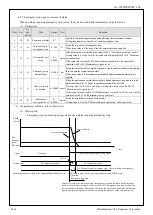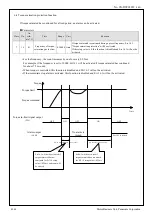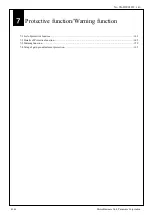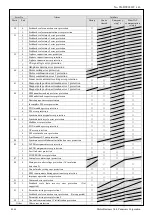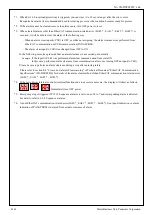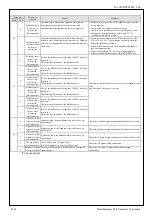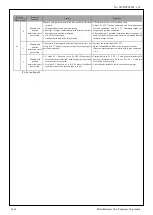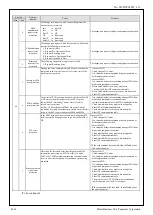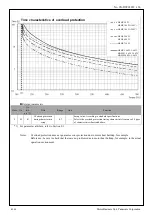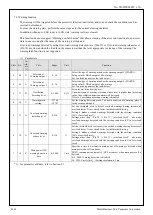
No. SX-DSV02829 -
145-
7-2 Details of Protective function
Error No.
Protective
function
Causes
Measures
Main Sub
11
0
Control power
supply
undervoltage
protection
Voltage between P and N of the converter portion of the control
power supply has fallen below the specified value.
Measure the voltage between lines of connector and
terminal block (L1C–L2C).
1) Power supply voltage is low. Instantaneous power failure
has occurred
1) Increase the power capacity. Change the power supply.
2) Lack of power capacity...Power supply voltage has fallen
down due to inrush current at the main power-on.
2) Increase the power capacity.
3) Failure of servo driver (failure of the circuit)
3) Replace the driver with a new one.
12
0
Over-voltage
protection
Power supply voltage has exceeded the permissible input
voltage. = Voltage between P and N of the converter portion of
the control power supply has exceeded the specified value.
Source voltage is high. Voltage surge due to the
phase-advancing capacitor or UPS (Uninterruptible Power
Supply) have occurred.
Measure the voltage between lines of connector (L1, L2 and
L3). Enter correct voltage. Remove a phase advancing
capacitor.
1) Disconnection of the regeneration discharge resistor
1) Measure the resistance of the external resistor
connected between terminal P and B of the driver.
Replace the external resistor if the value is
∞
.
2) External regeneration discharge resistor is not appropriate
and could not absorb the regeneration energy.
2) Change to the one with specified resistance and
wattage.
3) Failure of servo driver (failure of the circuit)
3) Replace the driver with a new one.
13
0
Main power
supply
undervoltage
protection (PN)
Instantaneous power failure has occurred between L1 and L3
for longer period than the preset time with Pr 5.09 (Main power
off detecting time) while Pr 5.08 (LV trip selection at the main
power-off) is set to 1. Or the voltage between P and N of the
converter portion of the main power supply has fallen below the
specified value during Servo-ON.
Measure the voltage between lines of connector (L1, L2 and
L3).
1) Power supply voltage is low. Instantaneous power failure
has occurred
1) Increase the power capacity. Change the power supply.
Remove the causes of the shutdown of the magnetic
contactor or the main power supply, then re-enter the
power.
1
Main power
supply
undervoltage
protection (AC)
2) Instantaneous power failure has occurred.
2) Set up the longer time to Pr 5.09 (Main power off
detecting time). Set up each phase of the power
correctly.
3) Lack of power capacity...Power supply voltage has fallen
down due to inrush current at the main power-on.
3) Increase the power capacity. For the capacity, refer to
Reference specification
SX-DSV02828
“Driver and List
of Applicable Peripheral Equipments” of Preparation.
4) Phase lack...3-phase input driver has been operated with
single phase input.
4) Connect each phase of the power supply (L1, L2 and
L3) correctly. For single phase, 100 V and 200 V driver,
use L1 and L3.
5) Failure of servo driver (failure of the circuit)
5) Replace the driver with a new one.
14
0
Over-current
protection
Current through the converter portion has exceeded the
specified value.
1) Failure of servo driver (failure of the circuit, IGBT or other
components)
1) Turn to Servo-ON, while disconnecting the motor. If
error occurs immediately, replace with a new driver.
2) Short of the motor wire (U, V and W)
2) Check that the motor wire (U, V and W) is not shorted,
and check the branched out wire out of the connector.
Make a correct wiring connection.
3) Earth fault of the motor wire
3) Measure the insulation resistance between motor wires,
U, V and W and earth wire. In case of poor insulation,
replace the motor.
4) Burnout of the motor
4) Check the balance of resister between each motor line,
and if unbalance is found, replace the motor.
5) Poor contact of the motor wire.
5) Check the loose connectors. If they are, or pulled out,
fix them securely.
1
IPM error
protection
(IPM: Intelligent
Power Module)
6) Welding of relay contact for dynamic braking due to
frequent servo ON/OFF operations.
6) Replace the servo driver. Do not use servo ON/OFF
during operation.
7) Timing of pulse input is same as or earlier than Servo-ON. 7) Enter the pulses 100 ms or longer after Servo-ON.
8) The dynamic brake circuit was overheated and the thermal
fuse is blown. (Only size F and size G)
8) Replace the driver.
(To be continued)
R1.00
Motor Business Unit, Panasonic Corporation




